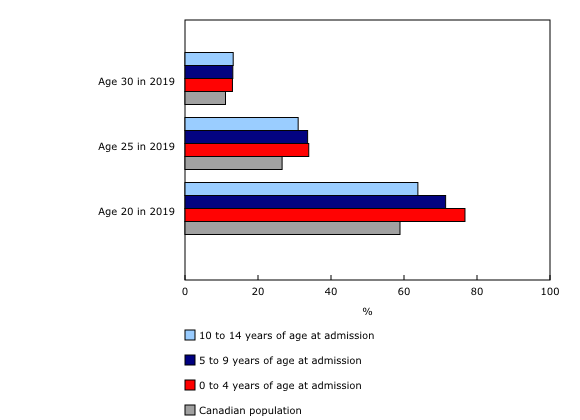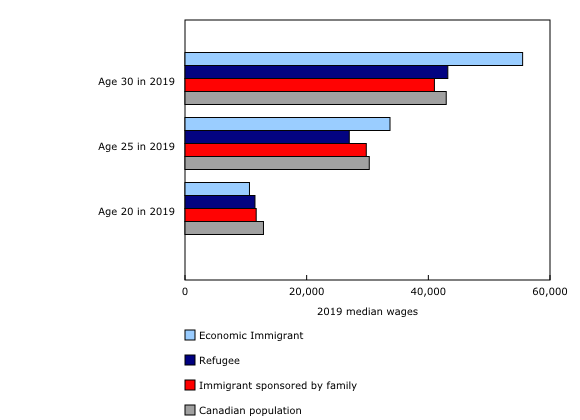Socioeconomic outcomes of immigrants admitted to Canada as children, 2019
Archived Content
Information identified as archived is provided for reference, research or recordkeeping purposes. It is not subject to the Government of Canada Web Standards and has not been altered or updated since it was archived. Please "contact us" to request a format other than those available.
Released: 2022-02-03
The most recent data from the Longitudinal Immigration Database (IMDB) indicate that factors such as participation in the Canadian education system and official language proficiency help immigrants who came to Canada as children earn wages similar to those of their Canadian-born peers during adulthood.
This analysis examines the characteristics of immigrants who came to Canada as children and their socioeconomic outcomes, such as participation in postsecondary education and median wages, based on income tax data in 2019.
The IMDB provides a long-term perspective on how immigrant children integrate into Canadian society. In addition, the 2019 data contribute to baseline estimates in preparation for future research on the impact of the COVID-19 pandemic on immigrant children, their adjustment period, and their long-term socioeconomic outcomes in adulthood.
Immigrants admitted as children participate in postsecondary education more often than the overall Canadian population, with those admitted at younger ages participating the most
Participation in postsecondary education was relatively high for immigrants admitted to Canada before the age of 15. This observation is based on tax filers who were between the age of 18 and 30 years in 2019 and who claimed postsecondary tuition fees in the same year. In 2019, the postsecondary education participation rate was 70.3% for 20-year-old immigrants admitted as children, compared with 58.9% of the overall Canadian population. At age 25, the participation rate was 32.7% for immigrants admitted as children and 26.6% for the overall Canadian population.
Among immigrants admitted as children, postsecondary education participation generally decreased as immigrants' ages at admission increased. In 2019, 76.7% of 20-year-old immigrants admitted before their fifth birthday participated in postsecondary education in Canada. The participation rate was 71.4% for those admitted between the ages of 5 to 9 years, and 63.8% for those admitted between the ages of 10 to 14 years. The younger children are admitted to Canada, the more likely they are to enrol in postsecondary education. Various factors can affect postsecondary education participation, such as academic preparation and knowledge of official languages.
Furthermore, participation in postsecondary education amongst immigrants admitted as children appears to be related to their parents' socioeconomic characteristics. Canada's selection process for economic principal applicants heavily emphasizes their education, skills and work experience. As a result, the majority of immigrant tax filers admitted under this category have completed some postsecondary education at the time of their admission. Correspondingly, immigrants admitted as children of economic immigrant families have much higher postsecondary education participation than their counterparts admitted through other immigration categories, particularly during early adulthood. In 2019, 75.4% of 20-year-old immigrants admitted as children of economic immigrant families participated in postsecondary education. The participation rate was 60.7% for those admitted with sponsored families and 58.9% for the overall population of Canada. Immigrants admitted as children of refugee families had the lowest participation in postsecondary education at age 20 (53.9%).
Immigrants admitted as children of economic immigrants report higher median wages than the overall Canadian population after their mid-20s
At age 20, immigrants who were admitted as children had lower median wages ($10,900) than the overall Canadian population ($12,900). This is associated with the immigrants' higher postsecondary education participation (70.3%) compared with the Canadian population (58.9%) of the same age. At age 25, median wages of immigrants reached $31,500, higher than the overall Canadian population ($30,290).
Different patterns were observed among adult immigrants in their mid-20s. At age 25, children admitted with economic immigrants had 11.3% higher median wages ($33,700) than the overall Canadian population ($30,290) of the same age. By comparison, median wages of those 25-year-old immigrants admitted as children of sponsored families ($29,800) and of refugees ($27,000) remained lower than the overall Canadian population of the same age.
Among 30-year-olds, immigrants admitted as children of economic immigrant families fared better than all others of the same age in the labour market. Their median wages ($55,500) were 29.3% higher than the overall Canadian population ($42,940) of the same age. The median wages were $43,200 for children admitted with refugee families and $41,000 for those admitted with sponsored families.
Overall, results from the 2020 IMDB show that immigrants' admission categories play a role in their children's participation in postsecondary education. These categories reflect their parents' socioeconomic background. Furthermore, participation in postsecondary education of immigrants admitted as children varies by age at admission. By the time they reach their mid-20s, economic outcomes of those admitted as children of economic immigrants started to fare better than the overall Canadian population. At age 30, immigrants admitted as children with sponsored families and refugee families had median wages comparable to the overall Canadian population of the same age.
Note to readers
Definitions and concepts
The Longitudinal Immigration Database (IMDB) is a comprehensive source of data that plays a key role in understanding the economic behaviour of immigrants and non-permanent residents. It is the only annual Canadian dataset that allows users to study the characteristics of immigrants to Canada at time of admission and the economic outcomes and regional mobility of immigrants over a period of more than 35 years.
The IMDB is the result of a partnership between Statistics Canada; Immigration, Refugees and Citizenship Canada (IRCC); and the provinces. The IMDB combines administrative files on immigrant admissions and non-permanent resident permits from IRCC with tax files from the Canada Revenue Agency (CRA). IRCC's administrative records contain extensive information on immigrants admitted to Canada since 1952. They also include information on non-permanent residents who have been granted a temporary resident permit since 1980. Fiscal data are available from the CRA's tax files for immigrant tax filers admitted since 1980. Income tax records for 1982 and subsequent years are available for immigrant tax filers.
The IMDB links short-term and long-term outcomes to characteristics at admission, such as immigrant admission class, country of origin and knowledge of official languages. The IMDB also provides information on pre-admission experience in Canada and citizenship acquisition since 2005.
For additional information regarding the data coverage and data quality of the IMDB, users should refer to the Longitudinal Immigration Database (IMDB) Technical Report, 2020.
Results from the IMDB are based on tax filers, individuals who have filed a tax return for a given tax year.
This release analyzes income based on the medians of wages (for the population with wage, salary or commission income, excluding self-employment income). The median is the level of income at which half of the immigrant tax filers have higher income and half have lower. Zero values are not included in the calculation of medians for individuals. All wage estimates are expressed in 2019 constant dollars to factor in inflation and enable comparisons across time in real terms.
Postsecondary education participation is defined as claiming tuition credits for oneself on the T1 tax return (Schedule 11) in the reference year. If the tax filer was a student during the tax year, he or she may claim tuition fees (not books or expenses) paid to an educational institution of post-secondary level in Canada. Beginning in 1997, only the qualified total amount of the student is kept in the IMDB. However, any unused part of the tuition amount may be carried forward and claimed in a future year. Any amounts carried forward cannot be transferred to a spouse, parent or grandparent at a later date.
Postsecondary education participation rate is defined as the proportion of tax filers claiming postsecondary tuition credits for oneself on the T1 tax return (schedule 11) in the reference year.
Immigrant children, also known as Generation 1.5, are immigrants who were admitted to Canada before the age of 15. This release analyzes the socioeconomic outcomes of this population between the ages of 18 and 30.
Overall Canadian population figures come from the T1 Family File, which uses data from filed tax returns to estimate income and demographic information for the total Canadian population, including immigrants. For more information, users can access the Technical Reference Guide for the Annual Income Estimates for Census Families, Individuals and Seniors.
Sponsored family immigrants include immigrants who were sponsored to come to Canada by a family member who is a Canadian citizen or permanent resident.
Refugees include immigrants who were granted permanent resident status on the basis of a well-founded fear of returning to their home country. These include government-assisted refugees and privately sponsored refugees, as well as protected persons in Canada, and their dependants.
Economic immigrants include immigrants who have been selected for their ability to contribute to Canada's economy through their ability to meet labour market needs, own and manage or build a business, make a substantial investment, create their own employment, or meet specific provincial or territorial labour market needs. This category includes dependants admitted with the selected person.
Products
The "Longitudinal Immigration Database (IMDB) Technical Report, 2020" is available in PDF or HTML.
The data visualization tools "Longitudinal Immigration Database (IMDB) Interactive Application: Economic Outcomes" and "Longitudinal Immigration Database (IMDB) Interactive Application: Mobility" are available.
The IMDB products are available on the Immigrants and Non-Permanent Residents Statistics Portal.
The 2020 IMDB immigrant children data module is now available upon request.
Contact information
For more information, or to enquire about the concepts, methods or data quality of this release, contact us (toll-free 1-800-263-1136; 514-283-8300; infostats@statcan.gc.ca) or Media Relations (statcan.mediahotline-ligneinfomedias.statcan@statcan.gc.ca).
- Date modified:



